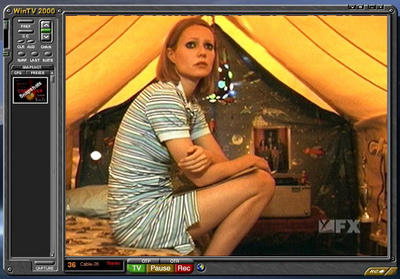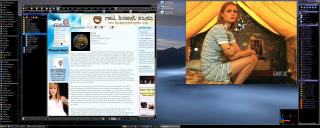Hauppauge WinTV PVR

TV tuners and Personal Video Recorders ("PVRs") are not exactly common. A TV tuner allows a user to watch TV on a computer whereas a PVR allow a user to pause and record television just like a TiVo. Whether you have a notebook or a desktop, these products offer great options for specific users like college students, who lug around a television every time they move. Some people with smaller work offices or bedrooms might need a TV tuner as well. The other great bonus is having a home-made "TiVo" without paying a monthly fee. Pause live television, have instant replays, and record as much as you want.
Sounds great, but there are some drawbacks.
I. Brand and Hardware
The biggest choice to make when purchasing a Tuner/PVR is picking a manufacturer. Although ATI and nVIDIA are making inroads into this market, Hauppauge has been the dominant player for quite some time in this niche market (much like the way Matrox has dominated the multi-monitor market). These cards are all available online and bigger retailers like BestBuy will have a few models laying around.
The biggest choice to make when purchasing a Tuner/PVR is picking a manufacturer. Although ATI and nVIDIA are making inroads into this market, Hauppauge has been the dominant player for quite some time in this niche market (much like the way Matrox has dominated the multi-monitor market). These cards are all available online and bigger retailers like BestBuy will have a few models laying around.
Once you pick a manufacturer, the next question is if you want a PVR/Tuner that is internal or external. The answer pivots mostly on whether you have a notebook or a desktop. Internal versions are PCI-based while externals almost always use USB 1.0 or 2.0 depending on how new the Tuner/PVR is. That I have not seen a FireWire-based external PVR/Tuner does not mean it doesn't exist.
Internal cards are faster; the channel will change very quickly and there's "less" lag when you hit the record button. External TV tuners, on the other hand, tax USB bandwith and use more system resources. Nevertheless, USB 2.0 is a fantastic option for notebook users. You might think it's silly to watch TV on your notebook, but if you've seen some of these insane widescreen notebooks lately, they have considerably better image quality than a small crappy cube television college students insist on buying. And, of course, an external TV tuner is not really all that big [about the size of a router], so you can drag it along with you somewhere if you want.
II. Features
Hauppauge offers a line of PVRs, which can be found at http://www.hauppauge.com/pages/prods_pvrs.html. As a bonus, Hauppauge's cards also have built in FM tuners, so you can listen to your local FM stations on your computer. I can't say this is really that great of a feature becuase I hardly use the FM tuner. But if it comes with the hardware, I'll take it.
Hauppauge's WinTV PVR has a hardware MPEG encoder, which instead of tying up your CPU in processing video, frees up your computer and does most of the work on its own. This not only allows you to keep using your computer as usual, but also helps video from becoming jerky or losing frames as you record.
As for image and recording quality, I can't say I am all that impressed. As you can see from the screen shot above, the video looks a bit murky (though this depends heavily on the quality of TV signal). I think all of the interference from other cables plugged into my computer have something to do with the picture looking a bit fuzzy at times.
Internal cards are faster; the channel will change very quickly and there's "less" lag when you hit the record button. External TV tuners, on the other hand, tax USB bandwith and use more system resources. Nevertheless, USB 2.0 is a fantastic option for notebook users. You might think it's silly to watch TV on your notebook, but if you've seen some of these insane widescreen notebooks lately, they have considerably better image quality than a small crappy cube television college students insist on buying. And, of course, an external TV tuner is not really all that big [about the size of a router], so you can drag it along with you somewhere if you want.
II. Features
Hauppauge offers a line of PVRs, which can be found at http://www.hauppauge.com/pages/prods_pvrs.html. As a bonus, Hauppauge's cards also have built in FM tuners, so you can listen to your local FM stations on your computer. I can't say this is really that great of a feature becuase I hardly use the FM tuner. But if it comes with the hardware, I'll take it.
Hauppauge's WinTV PVR has a hardware MPEG encoder, which instead of tying up your CPU in processing video, frees up your computer and does most of the work on its own. This not only allows you to keep using your computer as usual, but also helps video from becoming jerky or losing frames as you record.
As for image and recording quality, I can't say I am all that impressed. As you can see from the screen shot above, the video looks a bit murky (though this depends heavily on the quality of TV signal). I think all of the interference from other cables plugged into my computer have something to do with the picture looking a bit fuzzy at times.
Pausing live television is hit or miss sometimes. There are plenty of options for choosing the quality of recording you want so that you don't fill up your hard drive recording one movie. While Hauppauge touts that you can easily burn your recorded video to VCD, the process is time consuming and riddled with formatting and processing problems including not limited to (1.) chirpy audio (2.) audio-video not syncing properly (3.) grainy video and (4.) lost/frozen frames.
Apart from recording video (and using it as a way to archive video), I thinkWinTV works very well in terms of pausing live television. This feature is invaluable whenever I had night classes or had to step out during a favorite primetime show. I just hit pause and (ten seconds later) it will freeze the channel. Whenever I come back, I hit play and I can watch. The video quality is more than watchable, but in comparison to a standard TV and VCR or a set-top PVR, you can't compare.
III. Bundled Software versus Third-Party Software
One of the things I hate about WinTV is how it is rather moody when it comes to resizing the window in WindowsXP. As some of you may know, standard TV signals are 640 x 480 resolution. Compare that to modern day computer displays that average 1280 x 1024, and you will see a pretty small TV window. For some reason, older versions of WinTV allowed users to easily resize windows, but the new PVRs do not. So if you keep stretching the window, the video will stop growing and you'll start to see black bars, which stinks.
As a fix, I have found fantastic third-party software called DScaler, which is availabe for free at http://deinterlace.sourceforge.net. This allows you to resize the window to whatever size you want. DScaler is compatible with a lot of different cards, though it does not have a lot of the bell and whistles found in the bundled software. Here's what my desktop looks like when I have the TV running. Note how I get rid of all the controls, so that I can just see the television screen (you can control the TV with simple, very intuitive keyboard commands).


IV. Conclusion
I love watching TV sitting in front of my computer. Having CNN muted on my desktop while I study or do legal research always helps me stay up to date. I highly recommend getting a basic TV tuner.
But as for getting a PVR, I think the technology is still too unreliable for it to replace a good VCR or a set-top PVR like a TiVo. I would not recommend WinTV for people who want to use it as a way to archive their video and store it for good.



No comments:
Post a Comment